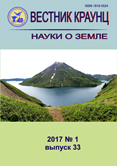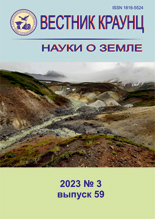Abstract
The peculiarities of the fractionation of rare earth elements (REE) were studied in three genetically similar types of soils in the territory of the humid subtropics of Russia. REE contents were determined by inductively coupled plasma mass spectrometry with full acid decomposition of samples. The following soils were studied: burozems formed on mudstones in the Mzymta river valley; burozems transformed to the state of abrozems formed on similar rocks in Sochi; and brown soils on carbonate rocks in the territory of the Utrish Reserve. Burozems formed in natural conditions on mudstones are characterized by REE fractionation with the predominance of their middle subgroup. In urban soils similar in genesis, an increase in the content of elements of the light subgroup is observed. These changes are due to their transformation as a result of urban load. Over the past 100 years, the soils of the city have undergone significant alkalinization, the index of pH in them increased by 2 units. The relationship between REE fractionation and soil acidity is confirmed by the REE distribution curve for the soils of the Utrish Reserve. The latter are distinguished by an even greater predominance of the light REE subgroup, due to the increased alkalinity of soils caused by the formation of soils on carbonate rocks.
References
Антонова С.А., Ладонин Д.В. Содержание редкоземельных элементов в почвах Центрально-лесного государственного природного биосферного заповедника // Почвоведение. 2022. № 2. С. 219–227 [Antonova S.A., Ladonin D.V. Rare earth elements in soils of the central forest state nature biosphere reserve // Eurasian Soil Science. 2022. V. 55. № 2. P. 191–199. https://doi.org/10.1134/S106422932202003X].
Артеменков А.А. Содержание редкоземельных элементов в почвах техногеохимических аномалий // Экологическая химия. 2020. 29(2). С. 101–112 [Artemenkov, A.A. The content of rare earth elements in soils of technogeochemical anomalies // Ecological Chemistry. 2020. 29(2). P. 101–112 (in Russian)].
Венцель Е.С. Исследование операций. М.: Высшая школа, 2001. 208 с. [Vencel’ E.S. Issledovanie operacij. Moscow: Vysshaya shkola, 2001. 208 p. (in Russian)].
Водяницкий Ю.Н. Геохимическое фракционирование лантанидов в почвах и горных породах (обзор литературы) // Почвоведение. 2012. № 1. С. 69–81 [Vodyanitskii Yu N. Geochemical fractionation of lanthanides in soils and rocks: A review of publications // Eurasian Soil Science. 2012. V. 45. № 1. P. 56–67. https://doi.org/10.1134/S1064229312010164].
Дабах Е.В. Материалы XV Всероссийской науч.-практ. конференции с международным участием. «Биодиагностика состояния природных и природно-технических систем». Киров, 2017. С. 137–140 [Dabah, E.V. Materialy XV Vserossijskoj nauch.-prakt. konferencii s mezhdunarodnym uchastiem. «Biodiagnostika sostoyaniya prirodnyh i prirodno-tekhnicheskih sistem». Kirov, 2017. P. 137–140 (in Russian)].
Джуринский Б.Ф. Периодичность свойств лантаноидов // Журнал неорганической химии. 1980. Т. 25. № 1. С. 41–46 [Dzhurinsky B.F. Periodicity of the properties of lanthanides // Journal of Inorganic Chemistry. 1980. V. 25. № 1. P. 41–46 (in Russian)].
Дорошкевич С.Г., Смирнова О.К. Труды VI Всероссийского симпозиума с международным участием и XIII Всероссийских чтений памяти академика А.Е. Ферсмана «Минералогия и геохимия ландшафта горнорудных территорий. Рациональное природопользование. Современное минералообразование». Чита: Изд-во БНЦ СО РАН, 2016. С. 107–113 [Doroshkevich S.G., Smirnova O.K. Trudy VI Vserossijskogo simpoziuma s mezhdunarodnym uchastiem i XIII Vserossijskih chtenij pamyati akademika A.E. Fersmana «Mineralogiya i geohimiya landshafta gornorudnyh territorij. Racional’noe prirodopol’zovanie. Sovremennoe mineraloobrazovanie». Chita: Izd-vo BNC SO RAN, 2016. P. 107–113 (in Russian)].
Дубинин А.В. Геохимия редкоземельных элементов в океане // Литология и полезные ископаемые. 2004. № 4. С. 339–349 [Dubinin A.V. Geochemistry of rare earth elements in the ocean // Lithology and Mineral Resources. 2004. V. 39. № 4. P. 289–307. https://doi.org/10.1023/B:LIMI.0000033816.14825.a2].
Захарихина Л.В., Литвиненко Ю.С. Радиоэкологические особенности почвенно-растительного покрова долины реки Мзымта Сочинского Черноморского побережья // АгроЭкоИнфо. 2019. (4). [Zakharikhina L.V., Litvinenko Yu.S. Radioecological features of the soil and vegetation cover of the Mzymta river valley of the Sochi Black Sea coast // AgroEcoInfo. 2019. (4) (in Russian)].
Захарихина Л.В., Буртовой А.В. Антропогенная эволюция желтоземов санаторной зоны г. Cочи // Почвоведение. 2020. № 6. С. 751–761. https://doi.org/10.31857/S0032180X20060143 [Zakharikhina L.V., Burtovoy A.V. Anthropogenic evolution of zheltozems in the Sochi sanatorium area // Eurasian Soil Science. 2020. V. 53. № 6. P. 820–828. https://doi.org//10.1134/S1064229320060149].
Злобина А.Н., Рихванов Л.П., Барановская Н.В., Фархутдинов И.М., Ванг Н. Распределение радиоактивных и редкоземельных элементов в почвах китайской провинции Гуандун // Почвоведение. 2019. № 6. С. 700–710. https://doi.org/10.1134/S0032180X19060133 [Zlobina A.N., Rikhvanov L.P., Baranovskaya N.V., Farhutdinov I.M., Wang N. Distribution of radioactive and rare-earth elements in soils of the guangdong province, China // Eurasian Soil Science. 2019. V. 52. № 6. P. 644–653. https://doi.org/10.1134/S1064229319060139].
Классификация почв России. М.: Почвенный инcтитут им. В.В. Докучаева. 2008. С. 57–61 [Klassifikaciya pochv Rossii. Moscow: Pochvennyi institut im. V.V. Dokuchaeva, 2008. P. 57–61 (in Russian)].
Ладонин Д.В. Сравнительная оценка адсорбции редкоземельных элементов некоторыми типами почв // Почвоведение. 2019. № 10. С. 1163–1171. https://doi.org/10.1134/S0032180X1910006X [Ladonin D.V. Comparative evaluation of adsorption of rare-earth elements in some soil types // Eurasian Soil Science. 2019. V. 52. № 10. P. 1175–1182. https://doi.org/10.1134/S1064229319100065].
Лаврищев В.А., Пруцкий Н.И., Семенов В.М. и др. Государственная геологическая карта Российской федерации масштаба 1:200 000. Серия Кавказская. Лист К-37-V. Изд. 2-е. СПб. 2002 [Lavrishchev V.A., Pruckij N.I., Semenov V.M. et al. Gosudarstvennaya geologicheskaya karta Rossijskoj federacii masshtaba 1:200 000. Seriya Kavkazskaya. List K-37-V. Izd. 2-e. SPb. 2002 (in Russian)].
Переломов Л.В. Взаимодействие редкоземельных элементов с биотическими и абиотическими компонентами почв // Агрохимия. 2007. № 11. С. 85–96 [Perelomov L.V. Interaction of rare earth elements with biotic and abiotic soil components // Agrochemistry. 2007. № 11. P. 85–96 (in Russian)].
Радомская В.И., Радомский С.М., Павлова Л.М., Кулик Е.Н. Особенности миграции редкоземельных элементов в природных и техногенных экологических системах на примере Албынского золоторудного месторождения Приамурья // Геоэкология. Инженерная геология Гидрогеология. Геокриология. 2017. № 1. С. 15–27 [Radomskaya V.I., Radomsky S.M., Pavlova L.M., Kulik E.N. Specific features of rare-earth element migration in natural and technogenic ecological systems. the case of Albynskoe gold deposit, the Amur region // Geoekologiya. Engineering Geology Hydrogeology. Geocryology. 2017. №. 1. P. 15–27 (in Russian)].
Черненко С.П., Рогожина Е.В., Керимзаде В.В. Активность каталазы и уреазы, как индикатор пирогенной нарушенности почв (заповедник Утриш, полуостров Абрау) // Субтропическое и декоративное садоводство. 2022. № 82. С. 221–237 https://doi.org/10.31360/2225-3068-2022-82-221-237 [Chernenko S.P., Rogozhina E.V., Kerimzade V.V. Catalase and urease activity as an indicator of pyrogenic soil disturbance (Utrish Reserve, Abrau Peninsula) // Subtropical and ornamental gardening. 2022. V. 82. P. 221–237 (in Russian)].
Aubert D., Stille P., Probst A. et al. Characterization and migration of atmospheric REE in soils and surface waters // Geochimica et Cosmochimica Acta. 2002. V. 66. Iss. 19. Р. 3339–3350. https://doi.org/10.1016/S0016-7037(02)00913-4
Fedotov P.S., Rogova O.B., Dzhenloda R.Kh. et al. Metal–organic complexes as a major sink for rare earth elements in soils // Environmental Chemistry. 2019. V. 16. Iss. 5. P. 323–332. https://doi.org/10.1071/EN18275
Ferreira M., Ferreira F., Paulo M. et al. Geochemical signatures and natural background values of rare earth elements in soils of Brazilian Amazon // Environmental Pollution. 2021. V. 277. P. 116743. https://doi.org/10.1016/j.envpol.2021.116743
Kagi H., Dohmoto Y., Takano S., Masuda A. Tetrad effect in lanthanides partitioning between calcium sulfate crystal and its saturated solution // Chemical Geology. 1993. V. 107. № 3. P. 71–82.
Litvinenko Y., Zakharikhina L. Geochemistry and radioecology of waters and bottom sediments of the Mzymta river, the Black sea coast // Geochemistry International. 2022. V. 60. № 4. P. 379–394. https://doi.org/10.1134/S0016702922030041
Mihajlovic J., Bauriegel A., Stärk H. et al. Rare earth elements in soil profiles of various ecosystems across Germany // Applied Geochemistry. 2019. V. 102. P. 197–217. https://doi.org/ 10.1016/j.apgeochem.2019.02.002.
Nesbitt H.W. Mobility and fractionation of rare earth elements during weathering of a granodiarite // Nature. 1979. V. 279. P. 206–216. https://doi.org/10.1038/279206a0
Palumbo B., Bellanca A., Neri R., Roe M.J. Trace metal partitioning in Fe-Mn nodules from Sicilian soils, Italy // Chemical Geology. 2001. V. 173. № 4. P. 257−269. https://doi.org/10.1016/S0009-2541(00)00284-9
Pang X., Li D., Peng A. Application of rare-earth elements in the agriculture of China and its environmental behavior in soil // Environmental Science and Pollution Research. 2002. V. 9. P. 143-148. https://doi.org/10.1007/BF02987462. PMID: 12008295
Samonova О.A., Aseyeva E.N., Chernitsova O.V. Data on rare earth elements in different particle size fractions of topsoil for two small erosional landforms in central European Russia // Data Brief. 2020. V. 30. P. 105450. https://doi.org/10.1016/j.dib.2020.105450
Soares D.G., Root R.A., Amistadi M.K. et al. Rare earth elements (REY) sorption on soils of contrasting mineralogy and texture // Environment International. 2019. V. 128. P. 279–291. https://doi.org/10.1016/j.envint.2019.04.022
Tripathi J.K., Rajamani V. Geochemistry and origin of ferruginous nodules in weathered granodioritic gneiss es, Mysre Plateau, Southern India // Geochimica et Cosmochimica Acta. 2007. V. 71. № 7. P. 1674–1688. https://doi.org/10.1016/j.gca.2007.01.001
Working Group WRB. World Reference Base for Soil Resources. International soil classification system for naming soils and creating legends for soil maps. World Soil Resources Reports. 2014. No. 106. FAO. Rome. 181 р.
Yasnygina T.A., Rasskazov S.V. Tetrad effect in rare earth element distribution patterns: evidence from the Paleozoic granitoids of the Oka zone, eastern Sayan // Geochemistry International. 2008. V. 46. № 8. P. 814–825.
Zakharikhina L., Rudev P., Paltseva A. Chemical composition and morphology of the Mediterranean mussel, Black Sea coast of Russia // Marine Pollution Bulletin. 2022. V. 179. P. 113692. https://doi.org/10.1016/j.marpolbul.2022.113692

This work is licensed under a Creative Commons Attribution-NonCommercial 4.0 International License.
Copyright (c) 2023 Л.В. Захарихина, А.К. Гуц, П.С. Лесникова

